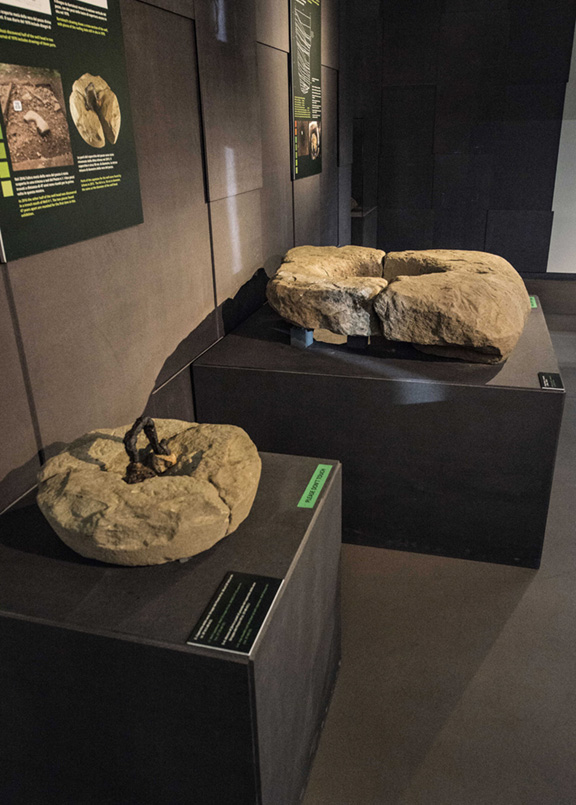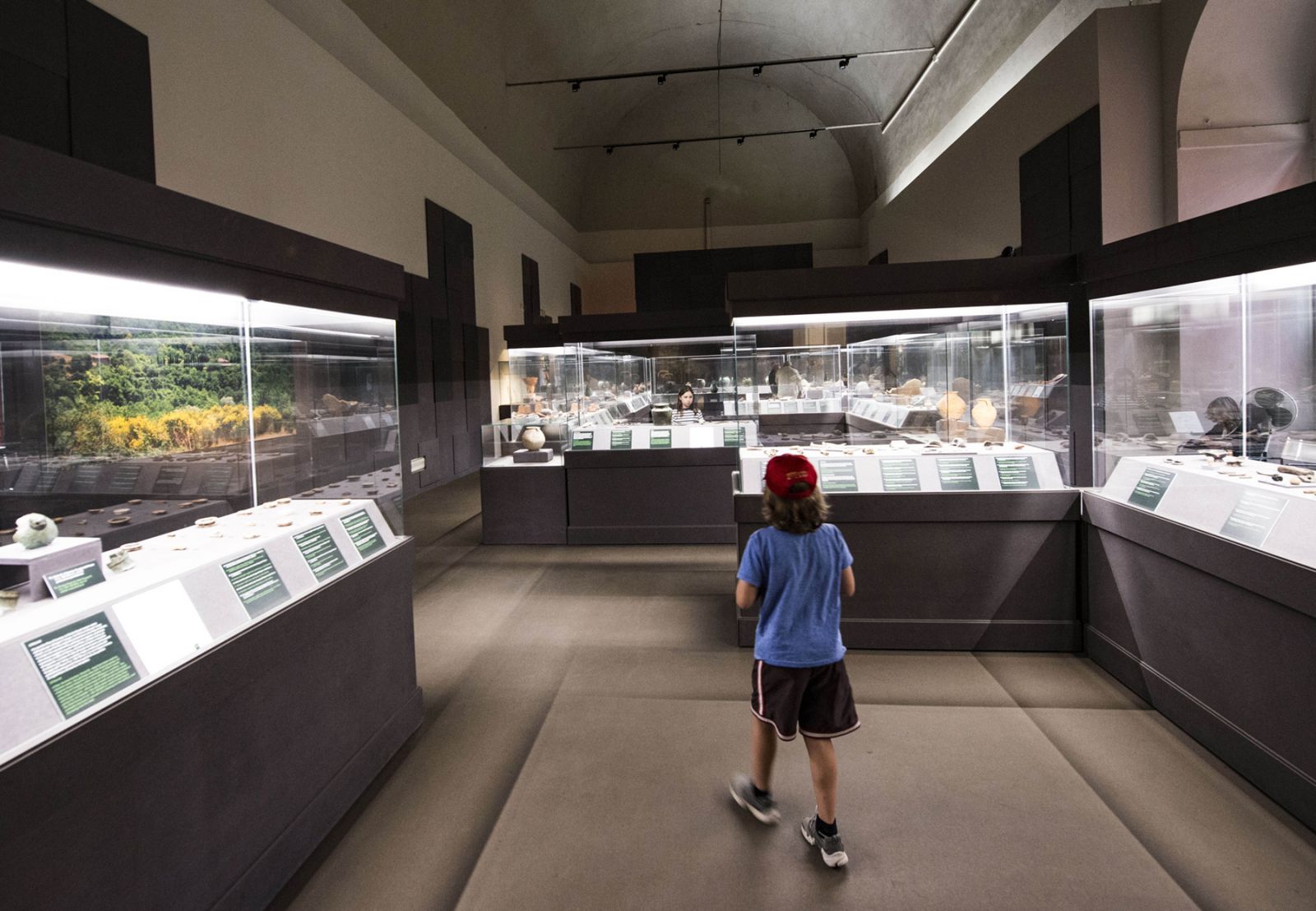American Journal of Archaeology | The Journal of the Archaeological Institute of America
You are here
Wells of Wonders: New Discoveries from Cetamura in Chianti
April 2018 (122.2)
Wells of Wonders: New Discoveries from Cetamura in Chianti
I pozzi delle meraviglie: Nuove scoperte a Cetamura del Chianti (Wells of Wonders: New Discoveries from Cetamura del Chianti), Museo Archeologico Nazionale di Firenze, Florence, 9 June 2017–30 September 2017, curated by Nancy T. de Grummond.
Wells of Wonders: New Discoveries at Cetamura del Chianti. Catalog of the Exhibition, June 9–September 30, 2017, Florence, National Archaeological Museum, MAF, Museo archeologico nazionale di Firenze, by Nancy T. de Grummond. Pp. 439. Edifir edizioni Firenze, Florence 2017. €40. ISBN 978-88-7970-843-2 (paper).
In Florence, a city full of expressions of remarkable human achievement, often missing is a sense of the quotidian context wherein those accomplishments are realized. But in the Salone del Nicchio of the city’s Museo Archeologico Nazionale, the relationship between the physical past and the environment of its creation is fully explored. The exhibition Wells of Wonders: New Discoveries from Cetamura del Chianti is a remarkable display of the results of decades of excavation and research, seamlessly joining both material presentation and archaeological process. As such, it offers an important model for archaeologists committed to engagement with an audience beyond the confines of academia, translating the nuance and detail of excavation into a narrative accessible to a broader public.
The study of Etruscan Italy is often overwhelmed by evidence collected from funerary environments. This show presents a different kind of Etruscan materiality, one created and informed by quotidian concerns. Most of the display presents finds from a pair of wells initially discovered in 1970 and excavated over the course of several subsequent campaigns, creating a distinctive tableaux of human use from the fourth-century B.C.E. Etruscan to the Late Roman period.
A video installation welcomes visitors to the exhibition and highlights both the discoveries from the site and the Florida State University excavation team’s long-standing field training and archaeological excavation program at Cetamura del Chianti. Additional videos and summary histories bracket the display space and explore the physical and logistical challenges associated with these profound spaces. They provide the viewer with a visceral sense of the complexity and danger associated with the delicate excavation of such a confined space scores of meters below ground.
The initial discovery of Cetamura’s wells was followed by years of intensive inquiry and effort associated with their excavation. As a result, the work was ultimately completed 44 years after their first identification. The bridge between past excavations and excavators is neatly symbolized by the presentation of two joining fragments of a limestone wellhead (fig. 1)1. The first fragment was recovered in 1970 upon the initial archaeological investigation of one of the wells. The joining fragment that completed the well cover was not recovered until 2016. This portion of the display elegantly characterizes the myriad ways in which archaeological research and discovery is always a process of incremental observation, built on generations of inquiry, a characteristic of our work that is often far removed from the popular imagination.
The first fragment was recovered in 1970 upon the initial archaeological investigation of one of the wells. The joining fragment that completed the well cover was not recovered until 2016. This portion of the display elegantly characterizes the myriad ways in which archaeological research and discovery is always a process of incremental observation, built on generations of inquiry, a characteristic of our work that is often far removed from the popular imagination.
Detailed bilingual didactic panels in Italian and English accompany the display and describe the history of the wells’ stratigraphic sequences and chronology. These panels are as informative to the specialist as they are accessible to the lay person and continue throughout the display, providing data and detail on the various periods of deposition within the wells. For example, the placard describing the wellhead and capstone of Well 1 not only presents the original use of these elements of the well’s architecture but also reproduces pages from the excavation journals, linking the well’s discovery to the materials’ place within the display’s interpretive framework.
The unusual nature of the Cetamura deposits is further reflected by the remarkable preservation of numerous discarded wooden objects and elements of the wells’ functionality during their earliest stage of use. Portions of wooden buckets, finials, and other everyday implements are presented along with wood objects of a more unusual nature, such as fragments of writing tablets recovered within various levels of the features. While the texts composed on them are now lost, the tablets are thought by the excavators to be associated with ritual behaviors involving the wells and access to the essential, life-sustaining water they provided. Quantities of animal bone were also recovered from the deepest elements of the wells. These deposits included several astragali that are also thought to be related to ritual and/or prophetic activities involving the wells, although precisely how is not explored.
It can, at times, be challenging to distinguish between evidence for ritual and nonritual behaviors in the archaeological record. Indeed, many of the most impressive discoveries from the wells highlight the overlapping of these categories. Bronze situlae and numerous fragments of vessel handles and ornaments suggest the wealth of the area’s inhabitants and hint at the specialized purpose of the wells themselves. This purpose clearly continued into the Roman period and throughout the functional life of the features. Objects of apparent value and importance continued to be placed within them. One such later example is of particular note for the application of whimsical lead feet in the form of bivalve cockle shells. Additionally, bronze and silver coins, iron implements of various forms, silver cutlery, and even an elegant bronze figurine of a calf were recovered from a locus rich with miniature vessels and small polished stones. The excavators consider many of these materials to be related to ritual behaviors linked to the wells over the course of their many centuries of use.
The wells also contained a rich assemblage of other forms of organic material. For excavators working in the region of Chianti, it must have been satisfying to recover direct evidence of ancient viticulture from within these spaces. Seeds of various species were also recovered, attesting to the vibrant tradition of Tuscany’s relationship to its various and abundant food sources. All too often, evidence of botanical remains from archaeological sites is relegated to tables published as appendices to site reports. But here, didactic plaques help situate the significance of these findings within the tradition of ancient viticulture and agriculture. Moreover, the display of actual specimens of seeds and grains is highly unusual for such exhibitions and executed in a manner that is truly elegant. The display also highlights the analyses of microscopic pollen samples, all of which serve to draw a rich picture of the agricultural traditions of the community surrounding these wells throughout their history.
Complementing the show is a catalogue that embraces much of the same material presented throughout the didactic displays, although in considerably greater academic detail. The volume’s text is organized in a manner that echoes the display, presenting historical treatments of the wells’ discovery, excavation, and chronology before detailing the various categories of materials recovered within them. These essays are clearly composed by scholarly experts, but the thoughtful and accomplished editing of the volume achieves a level of prose as accessible to the lay audience as it is informative to an academic one.
As one would expect from the aesthetically talented curators of the Museo Archeologico Nazionale di Firenze, the space of the Salone del Nicchio employed for Wells of Wonders is elegantly appointed and dramatically lit. The length of the space is appropriate for the show’s diachronic organization of materials from the earliest Etruscan deposits to the latest materials of the Roman period (fig. 2).
The show has few if any weaknesses. One minor reservation concerns the addition of materials associated with Cetamura del Chianti’s artisans’ sanctuary. The geo-spatial relationship between the artisans’ area and the wells is not made entirely clear, although points of symbolic and ritual contact between the two contexts are made throughout the display. Cetamura del Chianti is well known for its material related to artisan behaviors, and more didactic information associated with this scholarship would be welcome. Along similar lines, several features of the deposits are characterized throughout the display as ritual in nature. While the richness of many materials recovered from the wells is certainly unusual, the nature and purpose of such ritualized behaviors is at times underexplored or left to the realm of speculation.
This exhibition is indicative of a broader change at the Museo Archeologico Nazionale di Firenze. Long a museum dedicated to the abstracted and decontextualized display of Etruscan “art,” this venerable institution’s recent move toward concept-driven displays of its impressive holdings adds a fresh and entirely welcome dimension to its educational mission. The work of Nancy de Grummond, Cetamura’s longtime excavator and curator of the show, complements the change in the museum’s mission. The show’s introductory videos highlight de Grummond’s commitment to teaching archaeology through field experience. Her work as an educator of future generations of archaeologists goes hand in hand with the museum’s aim to inform the public about the process of archaeological research. De Grummond’s visionary use of three-dimensional printing to allow visually impaired students to engage with archaeological objects is also presented in the videos and demonstrates yet another creative and novel way that Wells of Wonders reimagines the purpose and effect of such a museum experience.
In this truly impressive exhibition, materials and data are shown through the lens of their archaeological, social, and ritual contexts, transforming the traditional display of objects into meaningful windows providing insight into the circumstances of their ancient use and deposition. The elegant and beautiful materials associated with Wells of Wonders are delights in their own right. But more than that, the show offers an ideal model for future presentations of complex and detailed archaeological work in a manner that is as visually compelling as it is educationally rich. It is a worthy and impressive capstone to years of dedicated work and study at the site of Cetamura del Chianti.
Shortly before this review went to press, the town of Gaiole in Chianti announced that it intends to use space in the newly renovated Cantine Ricasoli for a new museum dedicated to “Chianti storico.” The materials from Wells of Wonders will serve as the centerpiece of this museum’s presentation of the rich cultural history of the region, along with a range of additional material and information related to Florida State University’s excavations at Cetamura. This welcome news is further proof that an accessible, engaging presentation of archaeological research can be a crucial instrument for the promotion of regional tourism and economic development. For any archaeological project interested in developing such a partnership with their region, the Wells of Wonders exhibition offers an exemplary model to emulate.
Anthony Tuck
Department of Classics
541 Herter Hall
University of Massachusetts Amherst
Amherst, Massachusetts 01003
atuck@classics.umass.edu
- 1. Figures are my own.
Wells of Wonder: New Discoveries from Cetamura in Chianti
By Anthony Tuck
American Journal of Archaeology Vol. 122, No. 2 (April 2018)
Published online at www.ajaonline.org/online-museum-review/3612
DOI: 10.3764/ajaonline1222.Tuck
© 2018 Archaeological Institute of America

